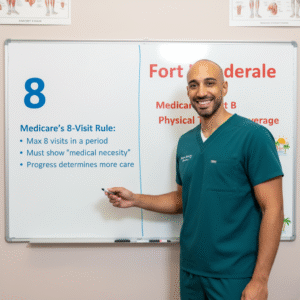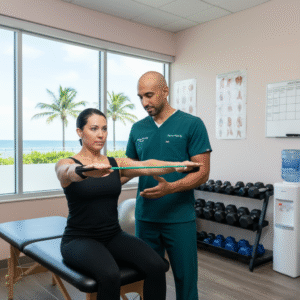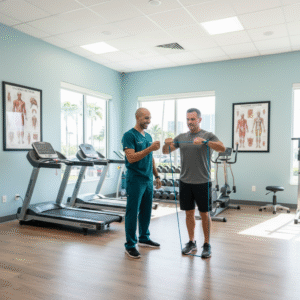Introduction
If you’re recovering from surgery, an injury, or managing chronic pain, you’ve probably heard the terms physical therapy and physical rehabilitation used, sometimes even interchangeably. But are they the same thing? While closely related, there are important differences between the two. Understanding these can help you make more informed decisions about your care, set realistic expectations, and choose the best treatment plan for your specific needs.

What Is Physical Therapy?
Physical therapy (PT) is a specialized branch of healthcare focused on restoring and improving movement, strength, balance, and function. It’s performed by licensed physical therapists who use evidence-based techniques and exercises tailored to each patient.
Common PT interventions include:
- Therapeutic exercise to build strength and flexibility
- Manual therapy (hands-on techniques to reduce pain or stiffness)
- Gait training and balance exercises
- Use of equipment like resistance bands or exercise balls
- Patient education on posture and movement habits
Physical therapy often targets a specific area or condition, like recovering from a knee replacement or treating lower back pain.
What Is Physical Rehabilitation?
Physical rehabilitation is a broader, more comprehensive process aimed at helping people regain physical, emotional, and sometimes cognitive abilities after illness, surgery, or injury. PT is part of rehabilitation, but rehab may also include:
- Occupational therapy (helping patients regain daily living skills)
- Speech therapy (for communication or swallowing issues)
- Pain management strategies
- Psychological counseling or support groups
- Use of assistive devices like braces or wheelchairs
Rehabilitation often takes a holistic approach, looking beyond just the physical injury to help patients return to daily life and activities.
Key Differences: PT vs. Physical Rehab
| Physical Therapy (PT) | Physical Rehabilitation | |
|---|---|---|
| Scope | Focuses specifically on movement, mobility, and physical function | Broad process addressing physical, emotional, and sometimes cognitive recovery |
| Providers | Licensed physical therapists | Includes PTs, occupational therapists, speech therapists, psychologists, etc. |
| Goal | Restore strength, flexibility, and reduce pain in targeted areas | Return to full daily life, independence, and quality of life |
| Approach | Mostly exercise-based and manual techniques | Multidisciplinary, holistic care plan |
When Do You Need Physical Therapy?
Physical therapy is often recommended for:
- Recovering from orthopedic surgeries (knee, hip, shoulder)
- Sports injuries like sprains and strains
- Chronic pain (lower back, neck, arthritis)
- Posture and balance problems
- Preventing re-injury through strengthening and education
A PT, along with shockwave therapy, can help restore function and mobility so you can return to your normal activities faster.
When Is Physical Rehabilitation the Better Fit?
Rehabilitation programs are usually recommended after:
- Major accidents (e.g., car crash, severe fractures)
- Stroke or neurological conditions (e.g., Parkinson’s, MS)
- Complex surgeries (e.g., spinal cord injury)
- Long hospital stays lead to significant deconditioning
Rehab addresses not only the physical healing but also emotional well-being, home adaptation, and daily living skills.
How They Work Together
Often, physical therapy is just one component of a broader rehabilitation plan. For example:
- After a knee replacement, PT helps regain knee strength and flexibility.
- Simultaneously, occupational therapy can help you adapt to daily tasks, such as climbing stairs or bathing.
- A pain specialist may help manage discomfort during recovery.
Together, this holistic approach helps patients recover more fully, regain independence, and improve quality of life.
Benefits of Each
| Physical Therapy | Physical Rehabilitation |
|---|---|
| Faster recovery after injuries | Regaining independence in daily activities |
| Reduce pain without medication | Emotional and psychological support |
| Improve strength, mobility, and flexibility | Social integration and adaptation to life changes |
| Prevent future injuries through proper body mechanics | Comprehensive, team-based approach |

Final Thoughts
In summary, physical therapy and physical rehabilitation are closely connected, but not the same. PT zeroes in on restoring movement and strength, often for specific injuries or surgeries. Physical rehabilitation, on the other hand, takes a holistic, team-based approach to help you return to daily life after more complex health challenges.
If you’re recovering from an injury, surgery, or serious illness, talk with your healthcare provider about which approach, or combination of both, can help you achieve the best possible outcome. Contact us today!






